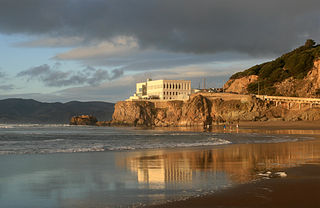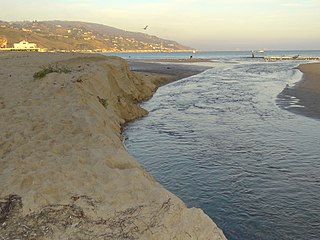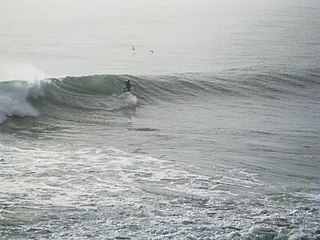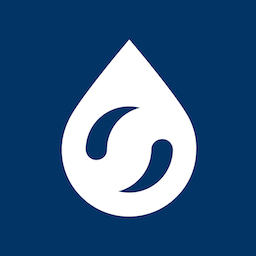
Surfing is a surface water sport in which an individual, a surfer, uses a board to ride on the forward section, or face, of a moving wave of water, which usually carries the surfer towards the shore. Waves suitable for surfing are primarily found on ocean shores, but can also be found in standing waves in the open ocean, in lakes, in rivers in the form of a tidal bore, or in wave pools.

Pūpūkea is a community and census-designated place (CDP) in the Koʻolauloa District on the island of Oʻahu, City & County of Honolulu, Hawaii, United States. In Hawaiian, pūpūkea means "white shell". As of the 2020 census, the CDP had a population of 5,130. The Koʻolauloa District ends at Waimea Bay, with the Waialua District extending south and westward.

Robert Kelly Slater is an American professional surfer, best known for being crowned World Surf League champion a record 11 times. Slater is widely regarded as the greatest professional surfer of all time, and holds 56 Championship Tour victories. Slater is also the oldest surfer still active on the World Surf League, winning his 8th Billabong Pipeline Masters title at age 49.

Mission Beach is a community built on a sandbar between the Pacific Ocean and Mission Bay. It is part of the city of San Diego, California.

Ocean Beach is a beach on the west coast of San Francisco, California, United States, bordering the Pacific Ocean. It is adjacent to Golden Gate Park, the Richmond District, and the Sunset District. The Great Highway runs alongside the beach, and the Cliff House and the site of the former Sutro Baths sit at the northern end. The beach is a part of the Golden Gate National Recreation Area, which is administered by the National Park Service.

Black's Beach is a secluded section of beach beneath the bluffs of Torrey Pines on the Pacific Ocean in La Jolla, San Diego, California, United States. It is officially part of Torrey Pines State Beach. The northern portion of Black's Beach is owned and managed by the California Department of Parks and Recreation, while the southern portion of the beach, officially known as Torrey Pines City Beach, is jointly owned by the city of San Diego and the state park, but is managed by the city of San Diego. This distinction is important as Black's Beach is most known as a nude beach, a practice that is now prohibited in the southern portion managed by the city of San Diego.

San Onofre State Beach is a 3,000-acre (1,214 ha) state park in San Diego County, California. The beach is 3 miles (5 km) south of San Clemente on Interstate 5 at Basilone Road. The state park is leased to the state of California by the United States Marine Corps. Governor Ronald Reagan established San Onofre State Beach in 1971. With over 2.5 million visitors per year, it is one of the five most-visited state parks in California, hosting swimmers, campers, kayakers, birders, fishermen, bicyclists, sunbathers, surfers, and the sacred Native American site of Panhe.
The Triple Crown of Surfing is a Hawaii a specialty series of professional surfing events that have been held annually since 1983 on the North Shore of Oahu, a coastline whose winter swells can reach 50 feet (15 m) in height.

The Banzai Pipeline, or simply Pipeline or Pipe, is a surf reef break located in Hawaii, off Ehukai Beach Park in Pupukea on O'ahu's North Shore. A reef break is an area in the ocean where waves start to break once they reach the shallows of a reef. Pipeline is known for huge waves that break in shallow water just above a sharp and cavernous reef, forming large, hollow, thick curls of water that surfers can tube ride. There are three reefs at Pipeline in progressively deeper water farther out to sea that activate according to the increasing size of approaching ocean swells.

Surf culture includes the people, language, fashion, and lifestyle surrounding the sport of surfing. The history of surfing began with the ancient Polynesians. That initial culture directly influenced modern surfing, which began to flourish and evolve in the early 20th century, with its popularity peaking during the 1950s and 1960s. It has affected music, fashion, literature, film, art, and youth jargon in popular culture. The number of surfers throughout the world continues to increase as the culture spreads.

Charles M. Van Artsdalen was a surfer. He moved to La Jolla, California, from his birthplace of Norfolk, Virginia, at age 14. Van Artsdalen is best known as a pioneer of surfing 25-foot waves at such North Shore locations as Waimea Bay and Sunset Beach; and tube riding in Hawaii during the early 1960-1970s. A member of the Duke Kahanamoku Surf Team, he appeared in several surf movies and remained a fixture of the international surfing community until his death from alcohol-related illness in 1979.

Malibu Lagoon State Beach in Malibu, California, United States, is also known as Surfrider Beach. It was dedicated as the first World Surfing Reserve on October 9, 2010. The 110-acre (45 ha) site was established as a California state park in 1951. It lies within the Santa Monica Mountains National Recreation Area.

Peʻahi is a place on the north shore of the island of Maui in the U.S. state of Hawaii. It has lent its name to a big wave surfing break, also known as Jaws.

Rossnowlagh is a seaside village in the south of County Donegal, Ireland. It is about 8 kilometres (5 mi) north of Ballyshannon and 16 km (10 mi) southwest of Donegal Town. The area's 3 km (2 mi) long beach, or 2 km (1.2 mi) if measuring from the cliffs to Carrickfad, is frequented by walkers, surfers, windsurfers, kite-surfers and swimmers.

Swami's is an area in San Diego County that contains Swami's Beach and other local attractions. The beach, also known as "Swami’s Reef'" and "Swamis", is an internationally known surfing spot, a point break located in Encinitas, San Diego County, California. Swami's was named after Swami Paramahansa Yogananda, because the grounds and hermitage of the Self-Realization Fellowship ashram, built in 1937, overlook this reef point. The name "Swami's" is also given to the sand beach that extends south from the point to the next beach access point, which is next to the San Elijo State Beach camping area; this more southerly surf spot often goes by the name "Pipes".

Devils Punch Bowl State Natural Area is a state day use park on the central Oregon Coast in the United States. It is centered on a large bowl naturally carved in a rock headland which is partially open to the Pacific Ocean. Waves enter the bowl and often violently churn, swirl, and foam. Outside the bowl, ocean conditions are attractive to surfers near a large offshore rock pinnacle named Gull Rock, located about 1⁄2 mile (800 m) west-northwest of Devils Punch Bowl, which funnels and concentrates waves easily seen from the park. There are at least seventeen large rocks, part of Oregon Islands National Wildlife Refuge, which provide interesting wave viewing, and attract and provide a home for wildlife.

Chile has many beaches for surfing, especially in the northern region where the weather conditions attract many surfers from all over the world. Except for the winter months surfing is possible all year. The water temperature ranges from 15 to 20 °C. Although the waves in central Chile are bigger, the waves in the north are stronger and are usually better suited for surfing. The cold waters of central and southern Chile can be brutal to surf, therefore, surfers adventuring into those areas are strongly advised on using a protective wetsuit to protect against the elements.

The North Shore, in the context of geography of the Island of Oʻahu, refers to the north-facing coastal area of Oʻahu between Kaʻena Point and Kahuku. The largest settlement is Haleʻiwa.

Surfline is a company and website based in Huntington Beach, California that specializes in surf forecasting and surf reports, live webcasting, photography, videography, as well as editorial coverage of the sport of surfing. Surfline.com is now ranked 1,180 in the US and 5,784 in the world in terms of popularity compared to other websites and is now the largest provider of streaming HD coastal cams. Since 2003 it has taken on buoyweather.com and fishtrack.com (2012), on average the family of websites receives 175,000 visitors per day. The site includes streaming video, surf reports and forecasts. Surfline.com offers streaming cameras at 150 surf breaks, and is one of the larger surf cam websites. Surfline currently has approximately 50 employees.

Ecuador has many beaches for surfing: the coast of Ecuador is 2,237 km long. Surfable waves are available in Ecuador year-round, and surfers enjoy the mild year-round weather, especially in the northern region where the weather conditions attract many surfers from all over the world. Within this part of South America, Ecuador's neighbors Chile and Peru also offer great surfing. Many surfers in Ecuador use a protective wetsuit. Surf tourism is very important to the local economy, and the beaches offer significant enjoyment because of top quality waves combined with affordable prices for lodging and food compared to other surf destinations. There's also a national marine reserve off the coast, which has a gigantic whale population.


















